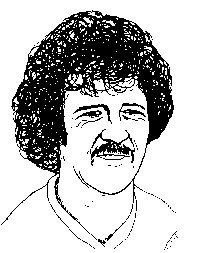
At long last, having made it to the First Division on a shoestring, Ray Bloye granted his manager some money to spend, and Venables could hardly contain his relief at being able to buy two 'big name' players. Gerry Francis, erstwhile England captain, had always been prone to injury but was still regarded as one of the country's most sophisticated midfield players,
| Mike Flanagan |
|---|
These two additions to the side did nothing to disrupt the cohesion of the team, and the quality of football played in the first couple of months of the season quickly dispelled the doubts that many people had about the true worth of Venables' young stars. Vince Hilaire, in particular, was looking exceptional and thriving on the service from an occasionally brilliant Francis. Jerry Murphy, reaching his peak tragically early in his career, epitomised the energy-saving approach to midfield play so favoured by Venables. Kenny Sansom, having played his first game for England in the post-season home international game against Wales, was already acknowledged as peerless in that position, and even Jim Cannon was looking like a player of International class.
Early results tended to suggest a difficult time ahead, with draws against Manchester City, Southampton and Middlesborough followed by another stalemate in the League Cup against Stockport, twice Palace's conquerers in that competition during the 1970s. Suddenly though, everything clicked and within a week they had beaten Derby County 4-0, and then slaughtered Stockport 7-0 in the home leg of the cup tie, with Flanagan scoring twice in each game. These two results set up a run of games during which Palace beat Aston Villa, Stoke and finally Ipswich, to end September at the top of Division One, along the way earning Terry Venables a bottle of whiskey. The victory over Ipswich
| Jim Cannon |
|---|
In moving to the top of the table with such style, the amount of publicity in the media reached a new level, beyond even Malcolm Allison's wildest dreams, and whichever hack coined the phrase "The Team of the Eighties" provided his fellows with an easy reference point for whatever they wrote about Palace for the next decade - most of it snide. At the time, though, the comment was all favourable, and it was easy to believe that Venables was in charge of a team capable of challenging the likes of Liverpool and Nottingham Forest at their own game. Dreams of the championship, and at the very least qualifying for Europe, were commonplace, and I have yet to hear a satisfactory theory for why everything went quite so badly wrong. The usual explanation is that the players were too green to handle the considerable pressure of success and lavish praise; whilst that is undoubtedly true of Sansom, it does not explain why the combined wisdom of Terry Venables and his lieutenant Gerry Francis could not keep them on a straight course towards the success of which they were surely capable. One thing is certain, that there was only one way to go, and Palace went that way with a vengeance for the next five years, with little respite and precious little to cheer.
| Gerry Francis |
|---|
| Jerry Murphy |
|---|
Already Kenny Sansom was talking about getting away, and his club form at least was in decline, and Jerry Murphy, not for the last time, appeared indifferent to what was happening. With goals becoming a rare commodity Dave Swindlehurst was made the scapegoat, and after being dropped in favour of Ian Walsh he was transferred to Derby County. He actually became a more dangerous player after leaving Selhurst Park, but it must be said that at the time he did look rather stale.
After being knocked out of the F.A.Cup at the third attempt by Swansea City, the end of the season became as dull and disappointing as the start had been bright and promising. The best late performance came in the 1-1 draw at Arsenal, where Sansom scored his only goal of the season and Pat Jennings saved a penalty from Gerry Francis, but with only one victory in the last ten games Palace collapsed to finish 13th in the table, still their highest position ever. The backlash had begun, but worse, far worse was to come.